Sex and the Supreme Court
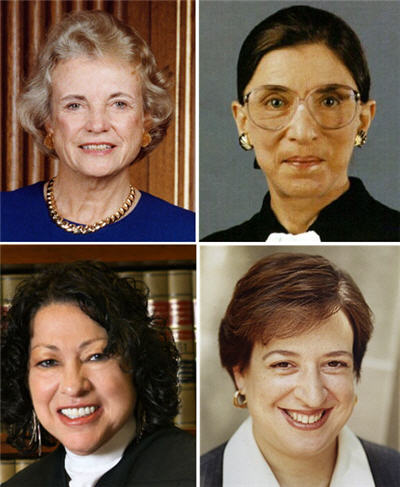 Responding to the fact that, by nominating Elena Kagan to the Supreme Court, Barack Obama has now gone two-for-two in appointing women to the High Court — and, assuming she’s confirmed, would triple the number of female Justices in a matter of months — NRO’s Kathryn Jean Lopez tweets, “Just wondering: are men allowed to be nominated to the supreme court anymore?”
Responding to the fact that, by nominating Elena Kagan to the Supreme Court, Barack Obama has now gone two-for-two in appointing women to the High Court — and, assuming she’s confirmed, would triple the number of female Justices in a matter of months — NRO’s Kathryn Jean Lopez tweets, “Just wondering: are men allowed to be nominated to the supreme court anymore?”
Ezra Klein retorts,
Assume that men and women are about equally capable of serving on the Supreme Court and there are about equal numbers of them in the country. The chance that two women in a row might be selected? About 25 percent. That is to say, it’s the same as the chance that you might flip a quarter and see it come up heads both times. And because the two events are theoretically independent (at least in our hypothetical), once a woman has been chosen for the first slot, the chances that a woman will be chosen for the second slot are 50-50. So Kagan, or someone of her gender, had an even shot.
Actually, it’s more complicated than that. While highly qualified lawyers with the right backgrounds of either sex are presumably equally qualified to serve on the Supreme Court, the number of highly qualified lawyers with the right background who are women is simply dwarfed by the number of highly qualified lawyers with the right background who are men.
The Bureau of Labor Statistics reports that only 32.4% of all lawyers in the United States in 2009 were women. That’s not surprising. After all, as recently as 40 years ago, most law schools discriminated against women — figuring they would quit work upon marrying and thus it was a “wasted” slot. Similarly, of the top 50 law firms in the country, only 14% had female managing partners and only 20% of the equity partners were women.
Now, those numbers are skewed somewhat by the inclusion of lawyers that are too old to realistically be candidates for SCOTUS appointment. Still, Kagan — young even by recent nominee standards — graduated law school in 1986. Even by that point, less than 40% of the law school graduates that year were women. The peak year, 1993, saw 50.4 percent of JD degrees go to women. But that quickly fell off and, for the 2008-2009 class, women made up 44% of law school students.
Furthermore, as a recent study conducted by Kaplan test prep (which administers the LSAT) found that, while 52% of male applicants to law school planned to run for political office in the future, that was true of only 34% of women. While that’s not a perfect proxy, it’s reasonable to extrapolate that — even now — men are more likely to go into politics than women.
Now, of course, we’re not talking about aggregate probabilities. Rather, President Obama is selecting from a pool of highly talented under-60 attorneys who have pursued a politically oriented career and have a judicial philosophy compatible with his ideals. Given that women are more likely to be Democrats, the skew is slightly straightened. Even so, there are doubtless more qualified male candidates for him to choose from.
All that said, I agree with Ezra that it’s not statistically shocking that Obama has picked two women in a row. For one thing, one presumes Obama is intentionally trying to diversify the Court. For another, it’s probably less remarkable than the fact that George H.W. Bush found Clarence Thomas, one of a relative handful of black Republicans, to be the most qualified person in the country to appoint back in 1991.
Still, it’s worth at least noting the anomaly that, of the three women who have sat on the Supreme Court in the history of the country, two are now on the bench and of the potentially four women who will have ever served on the Court, two will have been nominated back-to-back.
Oh, and I should note that a variant of Lopez’ joke has been told by Madeleine Albright who, playing off the fact that, since she was appointed to succeed Warren Christopher in 1997, we’ve had three women and two blacks as Secretary of State and quipped, “Somewhere in America, there’s a young man who believes that when he grows up, he may become Secretary of State; it’s just not exactly clear when.”

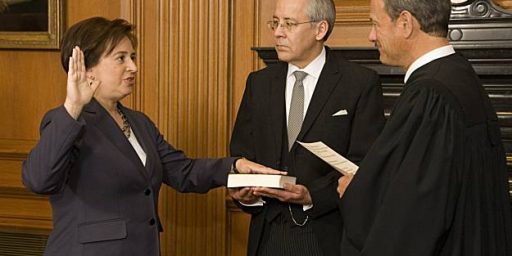
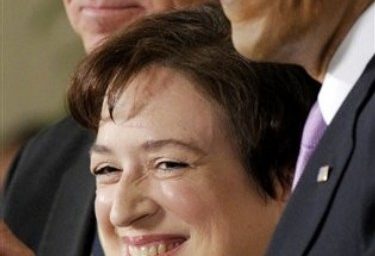
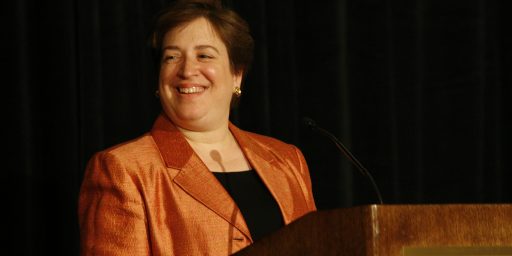

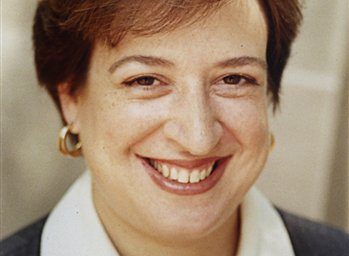
I’m not quire sure you’ve captured the most applicable grouping.
Most of the current justices don’t have significant private law firm experience, nor political experience.
Most do have an academic background as professors. Many have worked in government. I would expect that the number of women lawyers in academia and government has been comparable with men for a while.
For the most part, the pool for SCOTUS has been: sitting Court of Appeals judges. Some consideration is also given to solicitors general, White House counsels, and other high executive appointees. Those are still predominantly male.
I found some numbers from the ABA on women lawyers:
Women make up 29.7% of all lawyers. In specific areas they make up:
31.5% of law school faculty (but this ranges from 5.9% tenured to 48.0% assistant professors)
20.1% of US Circuit Court Judges
28% of DOJ attorneys
32% of other federal government
So, I’m wrong to assume that government/academic lawyers are close to 50%. (Still, women are more likely to pursue a legal career in government than men)
The reason I’m looking at academic background is that it appears to be a common foundation to get appointed on a Circuit Court.
What’s stupid about J-Lo’s comment is the presumption that there is some hierarchy of supreme court candidates ranked 1 through 10,000 and that Obama, at a minimum, skipped the male ranked number 1 to select a less-qualified female candidate; as if there is some perfect SCOTUS candidate that can be identified and selected, rather than the reality that the number of considerations that go into a SCOTUS pick make it pretty damn well impossible to identify the most “qualified” candidate, even if we could come to some agreement on what the relevant “qualifications” are, which we can’t.
And James makes a good point with Clarence Thomas, if there ever was a SCOTUS nominee that was eventually confirmed whose “qualifications” paled in comparison to the other idealogical acceptable nominees that were available, he’s the winner over the last 40 years, at least. If you want to expand to nominees who weren’t confirmed, then maybe he’s second to Harriet Miers, though I’m probably not recalling a Nixon appointee who got rejected.
Labor statistics aside, I can’t help but feel there’s a more ideological subtext to K-Lo’s question/comment. I’ve heard some conservatives admit rather openly in the past that they believe that any woman appointed to the court would support abortion rights or would be drawn to the center and/or left a la Sandra Day O’Connor.